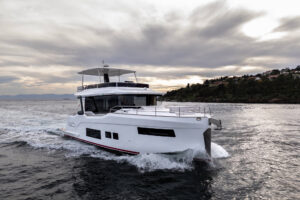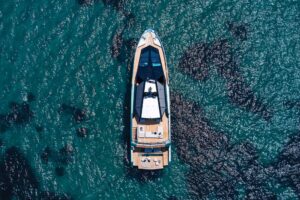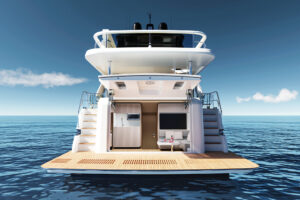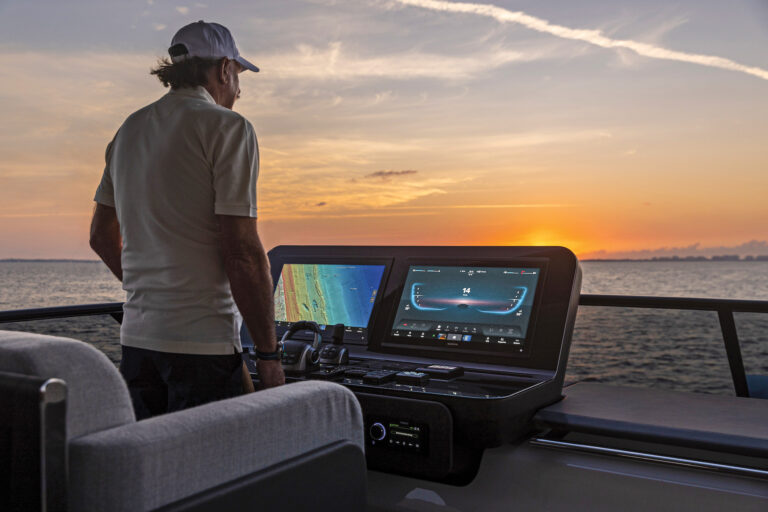Pekka Koskenkyla arrived at the design for this Escape 25m through a lifetime of thinking about boats, designing them, building them and cruising them. His most notable achievements are founding OY Nautor AB, builder of Swans, in 1966; designing the 40-meter sailing yacht Mirabella (with naval architecture and engineering by Bruce Farr) in the late 1980s; and designing the 70-foot Lotus motoryacht Voyager, on which he and his wife lived and cruised for five years.
“After five years of sailing the seven seas and with the experience of a person of a certain age”, Koskenkyla said, “I now care less for the sporting aspect and more for comfort and speed.”
With speed, he also wanted economy of operation for transoceanic range without the need for an oil well and refinery aboard. Only a power catamaran would serve his needs. Simple enough, but Koskenkyla wanted to sell versions of his dream to other yachtsmen and perhaps to the charter trade.
When a person decides to market his dream, everything changes. The inevitable compromises associated with any design become more restrictive, sometimes turning the dream into a nightmare.
Koskenkyla’s dream yacht, the Escape 25m, seems sensible enough from the beginning, so maybe she has a better-than-even chance at success.
Starting with a catamaran requires courage, even though the market for large power cats has grown substantially during the past 10 years. Many buyers learned to love the speed, comfort and livability of cats during charter trips, where the type seems to have a secure foothold. These folks saw beauty in the cat’s function and simply ignored or learned to live with the often peculiar appearance.
Converting die-hard monohull yachtsmen is another story. Koskenkyla addressed the ugly duckling image by giving the 25m a profile that could pass for monohull.
One design element traditional yachtsmen find hard to accept is the plumb stem common to many cats, power and sail. Koskenkyla, perhaps taking a cue from the likes of Alan Warwick, whose power cats are stunning, gave the 25m a severely raked stem that resembles the stem of many fine monohull motoryachts. The rake, in addition to reducing visual bulk in the forward sections, also slows the pitching motion of power cats that have too fine an entry. When the 25m digs into a head sea, the fine entry of each hull will let her ease into the wave, slicing the crest. The rapidly increasing buoyancy of her bow overhangs will carry her over what’s left of the wave, quickly damping pitch.
From the proud bows, Koskenkyla drew a sloping sheerline straight to lovely curved transoms. This curvature in the transoms makes the yacht seem lower in profile than she really is. It also helps carry the theme of forward thrust established by the bows. If the sheer weren’t as high as it is forward, the windows of the main deck would be seen at full height. This shows how important a single design element can be to a yacht’s overall impression.
Whether he intended to or not, Koskenkyla created a 21st century iteration of art deco in the superstructure. This is by no means a bad choice. You may recognize the window treatment as similar to some of the current Lagoon sailing cats-or maybe the observation deck of transcontinental railroad cars from the last century, or the backlight of Raymond Loewy’s 1949 Studebaker Starlight.
The superstructure of the 25m looks friendly and is practical. Upright windows reduce glare and solar heating of the interior, shed water more readily than sweptback windows and permit more of the interior volume to be used for living.
I love the fastback line of the pilothouse and the way it melts into the coaming of the play space on the bridge deck. The coachroof overhang shelters the bar and settee on the bridge deck and balances the look of the pilothouse, keeping it from looking like an afterthought.
Koskenkyla conceived the 25m as a fast displacement yacht. The hulls could also be labeled as the penetrating type. Although I haven’t seen a lines plan, I have seen a model. The flat bottom of each hull surprised me until I remembered that a fast ship also has a flat bottom. These flat sections will seldom leave the water, so pounding won’t be an issue until a foolish helmsman forgets to slow the boat in high seas. The reduction in draft for a given displacement offered by the flat bottoms far outweighs the possibility of pounding.
Though the sharp turn of the bilge created by a flat bottom develops drag-inducing eddies, this becomes moot when you apply 1,400 hp. I recall many pleasant hours rowing a flat-bottom, 24-foot-by-12-inch training shell. It was faster than most observers thought it would be. Also consider the flat bottom of an International 110 one-design sailboat, a very fast boat indeed.
Under-wing clearance and pounding caused by too little of it has been a problem for sailing and power cats. One of the more common ways to deal with this is to hang a V-shape bow from the under wing, as seen on the Escape 25m and the wave-piercing yachts from New Zealand Yachts. When the V-shape bow meets a wave, it deals with it in much the same way a V-bottom monohull does.
Dispersing the water reflected off the hulls and the V-bow in the center, though, requires careful thought. Many designers of power cats channel this battling water aft via semicircular sections between each hull and the bow. Water won’t compress, so the boat has to move itself or the water out of the way as quickly as possible.
Loads of interior volume is one of the catamaran’s most appealing characteristics. No monohull of reasonable proportions can equal a cat. The 25m has remarkably spacious accommodations. The main deck houses the owner and guests in the forward half. The after half of the main deck goes to dining, lounging and general entertaining.
The port hull has berths for four guests or crew, a reasonable amount of hanging locker space and three heads. The starboard hull contains two berths for crew and a complete galley. Portlights in the topsides and hatches overhead provide lots of natural light to the accommodations in the hulls. A pair of companionways, one on each side, provide passage to and from the hulls.
Koskenkyla plans to have the 25m built of aluminum, giving up the weight savings of advanced composite construction in favor of aluminum’s lower cost and superior resistance to damage from impact. A sailing yacht this size stands to gain more from a weight-saving program than does this motoryacht, so aluminum is a good choice. To reduce weight aloft, Koskenkyla specified the wheelhouse to be built of fiberglass over a PVC foam core.
This concept bears careful investigation by anyone who plans a life of extended voyaging, especially with their family. The space and economy of operation are hard to beat at the introductory price of $2.5 million.
Contact: Marine Industries, Inc., (954) 779-1094; fax (954) 463-0696; www.mii.cc; www.escapeyachts.net.









